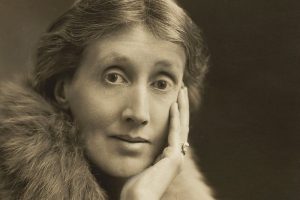
Last winter, Jack Shalom came across a Virginia Woolf novel that went out of copyright. A spark flew inside him as he remembered reading the novel in college. Luckily, for Pacifica Network that spark grew into a radio adaptation. By August, Jack had adapted, rehearsed, recorded, and edited the novel into a radio play with a troupe of fellow actors. In August, he spoke with Pacifica Network Coordinator Stephanie Schubert about the play and the process.
This interview has been edited for clarity and brevity.
Stephanie
To the Lighthouse is a novel by Virginia Woolf that you adapted for radio drama. You said it’s an experimental play. Can you talk about that?
Jack
To the Lighthouse was written in 1927. And it was kind of a break from Woolf’s previous novels, although she was always experimenting with form. This was at a time when James Joyce was writing, Marcel Proust was writing, and they were all playing around with what a novel could be–trying to break from that 19th century idea of Dickens who was a great novelist, but they were trying to find something different. They were modernists. And so in this novel in particular, Woolf begins to work in a stream of consciousness so that you’re reading inside the character’s thoughts, and then back to their dialogue, and then back to their thoughts and moving from one character to another character’s thoughts. You’re not even sure some of the time which character is thinking these thoughts. Sometimes the house itself is thinking these thoughts.
Stephanie
That is creative to have a house thinking thoughts. What is the set-up?
Jack
The two main characters are two women, Mrs. Ramsay and Lily Briscoe. Mrs. Ramsay is a British woman married with eight children. She is a real nurturer. She treasures relationships. She’s always trying to bring people together, trying to get them to get married, she’s a bit of a matchmaker. She throws large dinners at her summer vacation home. Everybody says she’s a remarkable woman. But it’s clear that she’s in a very rigid marriage with a man who’s a philosophy professor who’s a real intellectual and a kind of a selfish baby, he needs a lot of taking care of. And so on the one hand, we have this woman who treasures relationships, but is stuck in a rigid marriage. On the other hand, we have an artist who Mrs. Ramsay invites to her dinners, Lily Briscoe. And Lily as a woman, especially in that era, has decided that she’s going to go completely solo for her art: in order to become this painter that she wants to be, she disavows all the trappings of a relationship and family and so on. She doesn’t really understand it. What she understands is her pursuit of an artistic vision. And she has a very particular modernistic view just as perhaps Virginia Woolf did in her writing.
The novel takes place on just two days, at the same house, separated though, by ten years, because time is very important in this novel, and in this adaptation. And the two days, ten years apart, say, 1910 to 1920, are tied together by one goal, the goal of the six-year-old boy to take a journey to the lighthouse, a stormy boat ride away from their summer vacation house. And they don’t make it to the lighthouse on that first day. His father forbids the trip. But they attempt the trip ten years later, and the world has turned upside down. We’re talking about a World War, we’re talking about the worldwide Spanish Flu epidemic, deaths in the family, aging. It was a tremendous, tremendous thing. So as one character says, 10 years later, “I’m afraid you’ll find us much changed.” Well, yes, everybody is much changed. And so the play becomes kind of a ghost story about how people who are long gone can still linger in the air, in the very rooms that they once inhabited, and how even their psychological presence can linger within our personalities long afterwards, so that a six-year-old boy and girl rebuffed by their father still harbor resentments about not being able to go to the lighthouse. And ten years later, the question is, will they ever be able to get free from those resentments on their belated trip to the lighthouse? So, what we’re talking about is a kind of ghost story about loss, memory, artistic vision, choices that women in particular have, and reconciliation. And, you know, these are all kinds of invisible things. And that’s what those novelists in the 20s, particularly Virginia Woolf, were trying to do–capture something invisible. And that’s why it’s kind of an experimental mouthful. Because she’s talking about things we don’t talk about every day.
Stephanie
And like you said, Virginia Woolf reveals the invisible by sharing people’s thoughts while they interact.
Jack
Yes. Even at the dinner table where there’s the clink and clank of dinner, “Oh, please bring in the turkey, bring the roast beef, please, thank you good.” But in Mrs. Ramsay’s mind, she’s thinking, “Why is my husband groaning at me like that? Why is he talking that way? Why doesn’t he jump into the conversation, he would be ever so wonderful if he did.” And so, all these things are happening at once. So, yes, the invisible things are the thoughts. But also, I imagined it as if, like, you and I are talking right now. There are these invisible threads that go out to people, you know, and you can almost see them, you can see the different colors. And across the dinner table, you see these threads going back and forth, crisscrossing each other. But they get entangled and they get bashed up. And ten years later, it’s like spider webs that have disintegrated. There’s kind of a memory of it, but it’s not the same. And so it’s about the power that a personality has to affect the very air that we breathe in a way. So ,the story to me is fascinating because of that jump of ten years. And you know, it takes a long time for Virginia Woolf to set that up. And, our adaptation is true to the novel in that, the first day, ten years earlier, takes up the bulk of the play. And you think, Oh, this is kind of an interesting domestic story, but you don’t get ready for the devastation that comes very unannounced. That is not foreshadowed at all.
Stephanie
What draws you to this story?
Jack
Well, you know, I was so happy when I read that this novel was out of copyright, because it is a favorite. I first read it when I was in college–although a lot of it flew by me then because I wasn’t a sophisticated reader. But I did always remember this one speech by the husband, who’s the philosophy teacher. I always remembered that I completely identified with the type. But when I reread it, I was like, Oh, my God, this novel is incredible. The story of these two women. You know, that’s really what the story is about. And I had said to myself I would not do this unless I could get two particular actresses, Mary Murphy as Mrs. Ramsay and Lucy McMichael as Lily Briscoe because I knew those parts were perfect for them. And they’re wonderful actresses. And they both said yes! And they were both familiar with the book. They both said it was one of their favorite books! This was the world telling me I have to do it one way or another.
Stephanie
And why did you find it was a good fit for radio?
Jack
Well, I thought, now radio would be a very interesting medium into which to adapt this novel, because radio is the medium that is the most intimate I think of all, even more than theater & film. Radio is the most intimate for drama, and it requires the most imagination. I thought, maybe this could capture the essence of this Virginia Woolf novel.
I had heard that the copyright had expired this past January, and that gave me a lot of freedom. I didn’t have to worry about what I did with it. I wrote the adaptation in January and February–at least a first draft. We finished recording by the end of the first week or two in May. And then I’ve been spending all this rest of the time up to now, editing, mixing, putting the pieces together.
Stephanie
What did you have in mind when you were making the story work specifically for radio?
Jack
So the big thing is, how do you handle all the dialogue? If you took all the dialogue in Virginia Woolf’s novel, and spoke it, you probably could finish speaking it in just a half hour. That’s the outward frame, but the real meat of the play is in the thoughts of the character. So how do we do that? And the way that we decided to do it was that each actor who was doing the dialogue of a particular character would also voice the thoughts of that character—even if it was written in third person. For example, I played Mr. Ramsey. So I say to my son, “Oh, there’s no going to the lighthouse today, James.” And then I would say the thoughts, “Mr. Ramsay was never wrong. Mr. Ramsay was always right. He just thought that he had to say facts, strong facts were always important to Mr. Ramsay.” And then we can go back to the dialogue. So you hear my voice saying the dialogue and also the thoughts, but the thoughts are said in third person.
Stephanie
Okay. The actor plays both the dialogue and the thoughts. I can hear it in your voice, the change of your character moving into kind of a narrative stance, you take a little bit of a lighter tone with it.
Jack
Exactly, exactly. And even the six-year-old kid is always asking, “Are we going to the lighthouse? Mom, are we going to the lighthouse?” But then you hear his thoughts as an adult, “James Ramsay was just fascinated by lighthouses and always wanted to go”. So his narrative was an adult voice in the perspective of an older person. Yeah. It’s very interesting the way that goes in and out, and fun to do. The trick is in making it clear to an audience what is going on. 98% of my adaptation are the words of Virginia Woolf, it’s a matter of the selection and the order of how I put them. Maybe 2% is just to bridge the idea for radio; to clarify where we’re set in this scene or who is talking to whom in the scene, but otherwise, it’s pure Virginia Woolf. And it’s a bit Shakespearian because the language is so rich and beautiful, right? It does all the work, you don’t need to add extra bells and whistles.
Stephanie
Did you uncover any new insights while you were working through the story as actors?
Jack
Oh, gosh, yes. There were insights every minute. I don’t want to give away the main surprise of the play. Because there are a couple of shocking surprises, which you wouldn’t expect from the lighter tone of the beginning scenes. But yes, it’s a very Freudian play in its approach to family relationships.
Stephanie
Did you guys use any sound effects?
Jack
Oh, yes. That really was what the last month was, for me, it was about mixing in the sound effects and putting in the music. And I’ll tell you, this is a little crazy, but that’s my favorite part of the whole process. More than writing, acting, or directing it. It’s just sitting there with my headphones and editing. And, you know, sound is so amazing and so evocative, the sound of a seagull and a little bit of waves and, “oh, we’re at the beach” all of a sudden, you know? For a radio audience, it’s remarkable how little it takes to set a place. You know we’re at the dinner table just from the sound of knives and forks clinking in the background. It’s amazing. It’s magical.
Stephanie
Is there anything else that you want to get across about the play that we haven’t covered?
Jack
I think for those who want to listen to the play, the best conditions would be to use headphones, and set aside 90 minutes to become immersed in the world. You know, we tend to listen to radio as background, and we’re washing the dishes and so on. But I think you’ll get the most out of it, and enjoy it the most, if you set aside that time and try and treat yourself to this new world that you’re entering.
One more thing that I guess I wanted to say was that what I’ve realized about Virginia Woolf is she is very much like Chekhov as a writer in that she presents people, with all their foibles, all their ridiculousness, all their self-aggrandizement, in every single character. And I think this is by design: each character is wise, foolish, altruistic, and self-serving. And that’s what makes real people, these contradictions. So, I’m really beginning to appreciate Virginia Woolf as a novelist that really shows the full spectrum within individuals with the real flawed humanity that you can relate to.
Stephanie
It’s a domestic rollercoaster! I’m sure some radio stations would like to use this radio play for fundraising.
Jack
I think it’s excellent for fundraising. First of all, it’s unique. Nobody else is doing this. I mean, this is Pacifica. I’ve been listening to the Pacifica station WBAI in New York since I was 16 years old with my radio under the covers, you know, late at night. And there used to be quite a bit of radio drama then on Pacifica. This is something that alternative radio is made for, utilizing radio for all kinds of arts in a new way.

Stephanie
And you debuted the play on your show, Arts Express.
Jack
Yes, It’s a weekly arts magazine radio program. I’m a co-host, and I do interviews, and radio drama, and commentary. The show runs weekly on WBAI in New York, Wednesdays 9pm, and it’s on some of the affiliates as well.
Stephanie
This has been delightful. It’s been wonderful to hear you talk about this story. I’m excited about it. Thank you, Jack.
Jack
Thanks, Stephanie. I really appreciate it. I’m so happy that we worked on it. It just was such a treat.
Radio Stations can find To The Lighthouse in AudioPort under Specials. And general listeners can find the podcast of To The Lighthouse on the Arts Express website.
Lighthouse image by Frank Schulenburg

